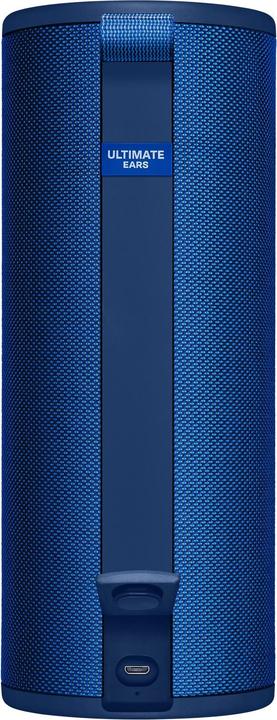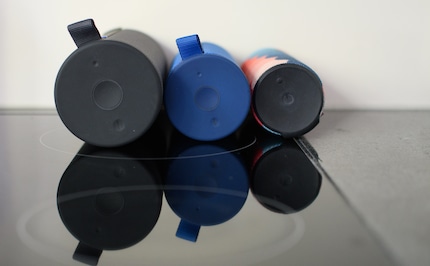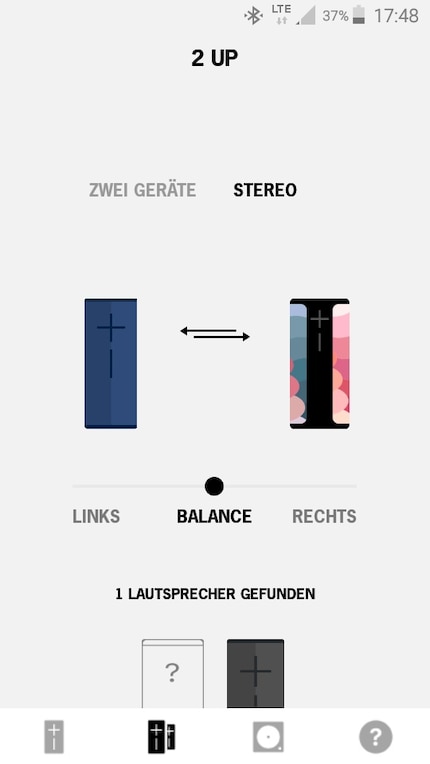

More Boom for your buck? We tested the new UE loudspeakers.
Both Bluetooth speakers UE Boom and UE Megaboom are available in the third generation. After testing them, I was both impressed and annoyed.
But first things first: the sound. The smaller UE Boom 3 delivers an impressively big sound for its size that easily fills your living room. It’s also great for the kitchen or in the bathroom. As it stands upright on its side, it doesn’t take up much space and you’re bound to find a spot for it. This is a real plus when it comes to sound quality. After all, the quality greatly depends on the position in the room and the distance to the walls.
These devices are also suitable for outdoor use. However, it’s questionable whether other people will appreciate your soundtrack.
As the name suggests, Megaboom 3 delivers more bass than Boom 3 – not least because of its size. This device sounds great. But the bass can almost become a bit too domineering if you’re using the speaker in a room with few sound-absorbing elements (as is the case in most kitchens and bathrooms). The app features an equaliser that allows you to add or remove bass and treble. Having said that, the equaliser cannot change the overall sound characteristic of the speaker.
This also becomes apparent when I compare the sound of the UE Boom 3 to the Boom 1. The latter has significantly less bass than the Boom 3 and generally sounds flatter – a drawback the equaliser can’t make up for. Although there’s not a huge difference to the Boom 3, it’s still very perceivable; even for non-audiophiles like myself. Unfortunately, I was unable to get my hands on a Boom 2 at such short notice. However, after reading the manufacturer’s description and test reports, the sound seems to be very similar.

Spatial sound yes, even distribution no
Ultimate Ears boasts with «360° sound» for their third generation. The volume buttons no longer sit on a rubber surface but directly on the fabric. Although this definitely looks prettier, there’s no loudspeaker beneath the buttons. In other words, also the third generation fails to emanate sound equally in all directions. Instead, the sound comes from both sides. In the video, I demonstrate this by covering the treble range (above). This changes the sound on the side and the treble is swallowed. If I cover the speaker with my hand at the front and the back, this doesn’t happen.
In spite of this, the speaker itself already creates a kind of spatial sound. This sparked my curiosity: What would two speakers sound like? Maybe I can replace my «real» hi-fi system with two Booms? No more cable clutter and no more massive speakers that need lots of space and generally produce too much bass reflex!
Stereo mode
Via the app’s party mode, you can simultaneously blast your music through up to 150 (!) Boom speakers. For this test, I have a Boom 3 and a Megaboom 3 at my disposal, so these two will have to do for now. Obviously, this creates even more spatial sound. I’m impressed from the start. But what about creating a stereo effect, meaning one speaker playing back the left channel and the other the right channel? The video below soon gives me the answer to this question: no. The sound coming from just the left or right channel is always played back over both speakers.
But a true stereo mode, which also allows you to select the balance, has existed for a while now. The EQ affects both speakers. In the past, it has not been possible to select stereo mode when you double up your Boom and Megaboom. It seems that nothing’s changed here. At least, I didn’t manage to do so with iOS or Android. However, to my surprise, the stereo mode is available if you combine Boom 1 and Boom 3.

Problems under Android
Some things did not run smoothly for me under Android. The app crashed quite frequently, the battery status constantly stayed at 20 per cent – which was completely wrong – I couldn’t switch the speaker off via the app and worst of all: When using several speakers in party mode, the music would regularly cut out. During my test, UE rolled out an update of the Android app. So I had to test everything all over again. Sadly, the update didn’t improve anything (as at: App version 7.0.206, 22 September). I used two different Android smartphones for my test; one of them with its factory settings.
At least the firmware update for Boom 3 and Megaboom 3 was easily done via the app. Unlike the update for Boom 1, which required me to install a software on my PC and hook up the speaker.
To pair Boom 3 after it was already paired with another device (but not connected), I had to reset the speaker each time. In other words, keep the power and minus button pressed for 10 seconds and then modify all the settings again. I doubt this was intended by the manufacturer. Sometimes, even this method didn’t work straightaway.
A little push into the water
Booms have been waterproof from the first generation. But UE Boom 3 comes with a small improvement: It is supposed to swim on the surface rather than sink to the bottom of whichever body of water it has ended up in. Apparently, this has always been the case with the Megaboom (I never tried it out). So if the speaker floats, does that mean you can listen to music when you’re on the water?
Not really. Even though the Bluetooth connection remained more or less stable, the speakers were under the water’s surface and the sound was hardly audible. After fishing it out again, the music sounds a bit tinny but not for very long. The speaker soon sounds like new again.
Even handier
The new Booms have an extra, multifunctional button: Push it once to pause or continue the music; push it twice to skip to the next track; hold the button to jump to the next playlist. The playlists are defined in the app. However, this feature doesn’t currently work for Spotify but is limited to Apple Music (iOS) or Deezer (Android). Under iOS, I was able to add locally stored music, for example full albums, to the playlist. This didn’t work under Android. If you don’t use Deezer, the button is only for play/pause or skip to the next track. Better than nothing.
A small yet nice change is that the charging cable is no longer connected underneath the speaker but on the side at the bottom. This means the speaker no longer has to be awkwardly positioned when it’s charging but stands upright as usual. What’s more, the latest generation is compatible with the charging station for the UE Blast. But I didn’t test it out.
Until now, the AUX input was also located on the underneath of the speaker, which was very impractical. But the manufacturer’s solution for this problem is disappointing: The cable input has been scrapped altogether. I’m not impressed. I like the option to connect a cable because it’s a lot less error-prone than Bluetooth. Plus it delivers a better sound quality (no additional compression).
The lowdown: mixed feelings
I get why Logitech has been successful with their Boom speakers. They’re just so handy. Not just on the go but at home, too. They’re definitely loud enough and the battery lasts long enough, as the predecessors proved. The new Booms sound and look good. Of course, beauty is in the eye of the beholder but, in my opinion, the design of version 3 is much nicer. In addition, the devices have been improved somewhat in terms of handling. However, if you already have a Boom, there’s no need to run out and get a new one.
But there are definitely some minus points, too. The problem with the Android app really annoyed me. And to forego the cable line-in altogether was a mistake. Under these circumstances, there’s no way I’m replacing my hi-fi system with two Booms.
My interest in IT and writing landed me in tech journalism early on (2000). I want to know how we can use technology without being used. Outside of the office, I’m a keen musician who makes up for lacking talent with excessive enthusiasm.

